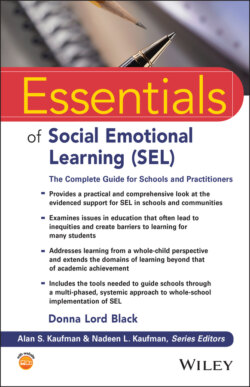Читать книгу Essentials of Social Emotional Learning (SEL) - Donna Lord Black - Страница 35
Process
ОглавлениеThe initial convening of the group focused on establishing the committee’s purpose and identifying project outcomes. After researching, examining, and discussing the issues on school mental health, the committee than set out to prioritize the issues and begin the process of developing a proactive, state intervention model. As discussions evolved, the committee began to realize that the development of a school‐based model was far more complex than originally anticipated. The evolution of this process brought to light a clear recognition that there could be no one solution for the commonly shared problems that schools faced when addressing student mental health. The committee acknowledged that this was largely due to the vast differences between the school communities in Texas, but also was partly due to how committee members perceived and understood the fragmented and complex systems regulating eligibility for mental health services, how those services were funded, availability and access to the services, and the occupational requirements that governed the professionals providing those services.
Each stakeholder involved in the project held a very different perspective on the issues of school mental health, and each member’s understanding of those issues was directly influenced by how she/he perceived the eligibility determination process for services. This included how the need for services was established and how the minimum standard of care was determined and evaluated. Consequently, the varied perspectives on these issues (i.e., lack of a common perspective) resulted in members struggling with how they might arrive at a possible solution to the problem.
During the early phases of the project, a significant amount of time was devoted to increasing the committee’s understanding of school systems and public education laws, including special education laws. Several non‐school stakeholders and parents in the group expressed concern with public school processes for identifying students who might need mental health services. Several of these stakeholders felt schools were consistently denying services to children, despite many of these students being diagnosed with mental health conditions. However, when the school professionals in the group responded to this concern, they explained that schools were obligated to provide educational services, and, although some educationally related services might be considered mental health services, the eligibility criteria for those services were established by education laws, not mental health or healthcare laws. These school professionals described the special education eligibility process (using acronyms commonly used in the special education process) and the educational programs provided through special education. This helped the committee members differentiate and better understand the services provided in public schools from those provided in the private sector or through public health services.
It soon became obvious to everyone that the language used to describe educational services was very different from the language used to describe mental health services. Clearly, this was an area where misperception and misunderstanding seemed to be perpetuating the problems and, ultimately, preventing any possible solutions. The group quickly recognized that the language used among the stakeholders (e.g., school vs. non‐school) was distinctly different, and frequently focused on how children were diagnosed versus how they were categorized, how services were educationally relevant versus clinically relevant, and how credentials held by each professional were regulated differently. Ultimately, these discussions led to the realization that a common language was essential in order for the group to develop a common understanding and perspective on the issues, for without a common perspective, the group would have difficulty arriving at a common vision for developing viable solutions.
